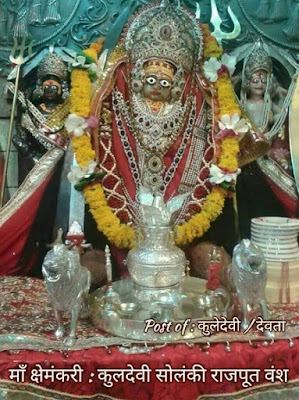 Rājpūt, Solankhi, Solanki, Chalukya.
Rājpūt, Solankhi, Solanki, Chalukya.—This clan was one of the Agnikula or fire-born, and are hence considered to have probably been Gurjaras or Gūjars. Their original name is said to have been Chaluka, because they were formed in the palm (
chalu) of the hand. They were not much known in Rājputāna, but were very prominent in the Deccan. Here they were generally called Chalukya, though in northern India the name Solankhi is more common. As early as A.D. 350 Pulakesin I. made himself master of the town
[466]of Vatapi, the modern Bādāmi In the Bijāpur District, and founded a dynasty, which developed into the most powerful kingdom south of the Nerbudda, and lasted for two centuries, when it was overthrown by the Rāshtrakūtas
1. Pulākesin II. of this Chalukya dynasty successfully resisted an inroad of the great emperor Harsha Vardhana of Kanauj, who aspired to the conquest of the whole of India. The Rāshtrakūta kings governed for two centuries, and in A.D. 973 Taila or Tailapa II., a scion of the old Chalukya stock, restored the family of his ancestors to its former glory, and founded the dynasty known as that of the Chalukyas of Kalyān, which lasted like that which it superseded for nearly two centuries and a quarter, up to about A.D. 1190. In the tenth century apparently another branch of the clan migrated from Rājputāna into Gujarāt and established a new dynasty there, owing to which Gujarāt, which had formerly been known as Lāta, obtained its present name
2. The principal king of this line was Sidh Rāj Solankhi, who is well known to tradition. From these Chalukya or Solankhi rulers the Baghel clan arose, which afterwards migrated to Rewah. The Solankhis are found in the United Provinces, and a small number are returned from the Central Provinces, belonging mainly to Hoshangābād and Nimār.
 Rājpūt, Solankhi, Solanki, Chalukya.—This clan was one of the Agnikula or fire-born, and are hence considered to have probably been Gurjaras or Gūjars. Their original name is said to have been Chaluka, because they were formed in the palm (chalu) of the hand. They were not much known in Rājputāna, but were very prominent in the Deccan. Here they were generally called Chalukya, though in northern India the name Solankhi is more common. As early as A.D. 350 Pulakesin I. made himself master of the town [466]of Vatapi, the modern Bādāmi In the Bijāpur District, and founded a dynasty, which developed into the most powerful kingdom south of the Nerbudda, and lasted for two centuries, when it was overthrown by the Rāshtrakūtas1. Pulākesin II. of this Chalukya dynasty successfully resisted an inroad of the great emperor Harsha Vardhana of Kanauj, who aspired to the conquest of the whole of India. The Rāshtrakūta kings governed for two centuries, and in A.D. 973 Taila or Tailapa II., a scion of the old Chalukya stock, restored the family of his ancestors to its former glory, and founded the dynasty known as that of the Chalukyas of Kalyān, which lasted like that which it superseded for nearly two centuries and a quarter, up to about A.D. 1190. In the tenth century apparently another branch of the clan migrated from Rājputāna into Gujarāt and established a new dynasty there, owing to which Gujarāt, which had formerly been known as Lāta, obtained its present name2. The principal king of this line was Sidh Rāj Solankhi, who is well known to tradition. From these Chalukya or Solankhi rulers the Baghel clan arose, which afterwards migrated to Rewah. The Solankhis are found in the United Provinces, and a small number are returned from the Central Provinces, belonging mainly to Hoshangābād and Nimār.
Rājpūt, Solankhi, Solanki, Chalukya.—This clan was one of the Agnikula or fire-born, and are hence considered to have probably been Gurjaras or Gūjars. Their original name is said to have been Chaluka, because they were formed in the palm (chalu) of the hand. They were not much known in Rājputāna, but were very prominent in the Deccan. Here they were generally called Chalukya, though in northern India the name Solankhi is more common. As early as A.D. 350 Pulakesin I. made himself master of the town [466]of Vatapi, the modern Bādāmi In the Bijāpur District, and founded a dynasty, which developed into the most powerful kingdom south of the Nerbudda, and lasted for two centuries, when it was overthrown by the Rāshtrakūtas1. Pulākesin II. of this Chalukya dynasty successfully resisted an inroad of the great emperor Harsha Vardhana of Kanauj, who aspired to the conquest of the whole of India. The Rāshtrakūta kings governed for two centuries, and in A.D. 973 Taila or Tailapa II., a scion of the old Chalukya stock, restored the family of his ancestors to its former glory, and founded the dynasty known as that of the Chalukyas of Kalyān, which lasted like that which it superseded for nearly two centuries and a quarter, up to about A.D. 1190. In the tenth century apparently another branch of the clan migrated from Rājputāna into Gujarāt and established a new dynasty there, owing to which Gujarāt, which had formerly been known as Lāta, obtained its present name2. The principal king of this line was Sidh Rāj Solankhi, who is well known to tradition. From these Chalukya or Solankhi rulers the Baghel clan arose, which afterwards migrated to Rewah. The Solankhis are found in the United Provinces, and a small number are returned from the Central Provinces, belonging mainly to Hoshangābād and Nimār.






